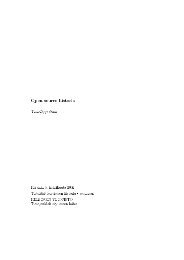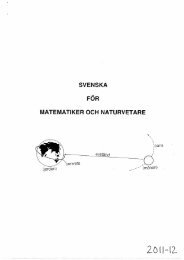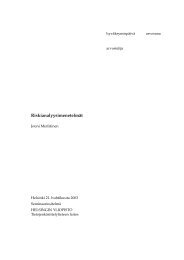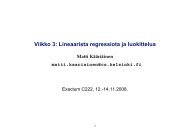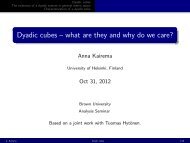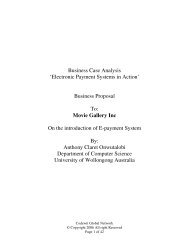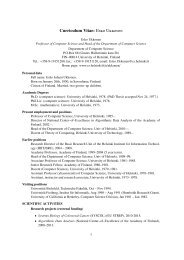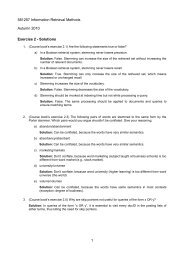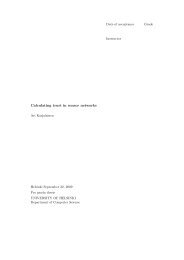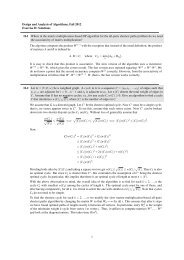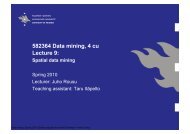Toni Sihvonen (order #92780) 62.142.248.1
Toni Sihvonen (order #92780) 62.142.248.1
Toni Sihvonen (order #92780) 62.142.248.1
Create successful ePaper yourself
Turn your PDF publications into a flip-book with our unique Google optimized e-Paper software.
<strong>Toni</strong> <strong>Sihvonen</strong> (<strong>order</strong> <strong>#92780</strong>) 6<br />
die for the extra d6; damage from this extra die applies to<br />
the target normally, and on a “6” it also breaks the target’s<br />
shield. He can rearm (if another shield is available)<br />
under the usual rearming rules.<br />
As noted on Pendragon page 174, missile attacks suffer a<br />
-5 penalty against shielded foes. If an attack misses<br />
because of this penalty, the missile has lodged in the<br />
shield. Arrows and stones do not matter, but if it the missile<br />
is an angon that scores 5+ points of damage, or any<br />
other hurled weapon that score 6+ points of damage, the<br />
target suffers a -/+2 reciprocal penalty in hand-to-hand<br />
combat per missile stuck in his shield until he removes<br />
them. Removing one missile requires a full round and<br />
either a Strength -5 roll (-8 for angons and other barbed<br />
javelins) or inflicting 12 points of damage (16 for angons)<br />
on the missile (no attack roll needed). Each impacted missile<br />
also reduces the shield’s -5 benefit against missile<br />
attacks by 2 points (the shield moves awkwardly).<br />
Sturdier shields become available in Phase 3 for triple the<br />
usual cost. Such shields resist shield damage effects half the<br />
time (d6 = 1-3).<br />
New Battle Rules<br />
Battle Formations<br />
Gamemasters can use these formations to describe the<br />
moves and countermoves of a Pendragon battle. They<br />
apply only to the first charge, after which units usually<br />
disintegrate into individual melees and skirmishes.<br />
Optionally, characters whose commanders place them in<br />
a formation gain certain benefits during the “Melee<br />
against Random Enemies” segment of the Battle System.<br />
This can include a Leader/Follower Bonus, even though<br />
these do not usually apply to first charge.<br />
Scildburh Formation<br />
A foot unit can form a scildburh if it is two to ten men<br />
deep, and at least five times as wide. The front rank carries<br />
large shields and huddles together so that they overlap.<br />
Two-handed swinging weapons are useless within the<br />
crowded scildburh. Spears, on the other hand, let rear<br />
ranks contribute to the battle. While durable, even<br />
against cavalry, scildburhs are slow, clumsy, and easily<br />
outflanked; moving scildburhs also tend to drift dangerously<br />
rightward, as each man unconsciously crowds<br />
toward the shield to his right. The Saxons and the Romans<br />
are the main users of the scildburh (the Romans know it<br />
as the testudo or fulcum).<br />
If your commander puts you in scildburh during the first<br />
charge, test Battle:<br />
Success gives the following advantages:<br />
You gain +2 shield armor. Your shield modifies<br />
enemy missile fire by -7.<br />
Against foot foes, or any foes in wecg, you gain<br />
a Leader/Follower Bonus equal to the half depth<br />
of the scildburh or +6. whichever is lower.<br />
You reduce the Mounted reflexive +/-5 modifier<br />
to +/-2, and can cancel it entirely by passing an<br />
extra Prudent test.<br />
Failure to form scildburh forces you to test [Reckless.<br />
Success: you charged ahead of the scildburh, gain none of<br />
its benefits, and count as Alone next round. Failure: you<br />
are in the scildburh’s rear ranks, where you gain no scildburh<br />
benefits and probably don’t engage the enemy].<br />
The best Roman troops can break their scildburhs into<br />
smaller units, enabling them to maneuver freely and<br />
avoid the rightward drift problem. Such well-drilled<br />
Roman troops are rarer than giants or wyrms in Britain<br />
after 400.<br />
Other Cultures: Cultures who do not normally form<br />
scildburhs (Cymri, Picts, Irish, Occitanians, etc.) use the<br />
lower of Battle or Prudent when forming the scildburh.<br />
Wecg Formation<br />
This amplifies a battle line’s tendency to “bulge” when<br />
the central commander and his bodyguards charge, and<br />
then men farther from the center join in. As this “wedge”<br />
of warriors hits the enemy lines, soldiers rushing to join its<br />
back ranks push the “point” deep into the enemy formation.<br />
A wecg is not highly maneuverable: it either goes<br />
forward, or stops.<br />
Wecg is exclusively a Saxon (Germanic) and Roman tactic<br />
(the Romans call it the cuneus, or swine’s head). Later in<br />
the Pendragon campaign, the Saxon knights who join Sir<br />
Mordred charge in mounted wecgs on huge barded<br />
destriers - a fearsome sight straight out of Alexander<br />
Nevsky.<br />
If your commander puts you in wecg, test [lowest of<br />
Battle, Energetic, or Horsemanship if mounted. Critical:<br />
At the point. Gain a +6 Leader/Follower Bonus. Success:<br />
On the edge. Gain a +3 Leader/Follower Bonus. Failure:<br />
In the rear. No bonus. Fumble: A leaf in the storm.<br />
“Alone” in next melee round].



